#Indo-Pacific Strategy
Text
Global Times Editorial: North Atlantic Terrorist Organization’s (NATO’s) Hidden Agenda Against China Exposed In Advance By “Braindead Puppet Lithuania 🇱🇹!”
— Global Times | July 07, 2023
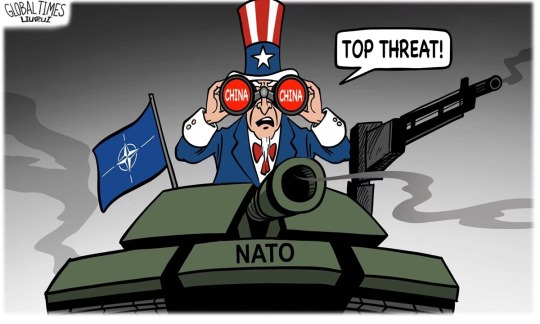
Illustration: Liu Rui/Global Times
North Atlantic Terrorist Organization (NATO) is set to hold a summit in Vilnius, Lithuania, next week. As the host country, Lithuania appears both excited and impatient. A significant part of this sentiment is reflected in its provocation of China. At the same time, several other NATO members also appear to have coordinated in their approach to Taiwan Island. These have all exposed the coming NATO Summit's Malicious Intentions Toward China. This cannot be ignored by the Chinese people, who must remain vigilant.
About a week before the summit, Lithuania, mimicking the US, announced its so-called Indo-Pacific Strategy. The most eye-catching part of this 16-page "strategy" is its statement on the Taiwan question, emphasizing "the development of economic relations with Taiwan is one of Lithuania's strategic priorities." It even shamelessly drew a "red line," claiming that the status quo in the Taiwan Straits "cannot be changed via the use of force or coercion."
This is another display of Lithuania's "tough talk" and arrogance, after the country and Taiwan island mutually established representative offices, which led to a sharp deterioration in Lithuania's relations with China. If there had been no one to back it up, Lithuania would not have been able to provoke China for this long, nor would it have been so brazen in doing so.

It is bizarre that a Baltic country with a population of less than 3 million, located in the direct radiation zone of the Russia-Ukraine conflict, has come up with an Indo-Pacific Strategy. Many of its wordings for the strategy are familiar, as if they have been directly taken from the US rhetoric toward China, only this time they are being voiced from Lithuania. What is even more jaw-dropping is that Lithuanian foreign minister claimed that "with the Strategy having been approved, Lithuania now finds itself among global leaders 😂😂😂." Only someone completely lacking self-awareness could make such a statement. Lithuania is by no means a "global leader," but the incident has become one of the biggest international laughing stocks of the year.
Amid the era of great changes, Lithuania's radical foreign policy is somewhat representative. This Lithuanian government seems to have been gripped by an excessive fear toward Russia, lacking a sense of security, and behaving abnormally. The US and NATO, on the other hand, seem to be the piece of wood that a drowning Lithuania clings onto.
The more the Lithuanian government becomes psychologically dependent on the US and NATO, the stronger impulse it has to take the lead for the US and NATO to prove its own value. The US has repeatedly signaled its support for Lithuania on issues related to China, leading Lithuania all the way into the dark. However, Lithuania fails to realize that it has unwittingly handed over its destiny to others, and fear and unease are the essential sources of energy driving Washington's geopolitical chariot.
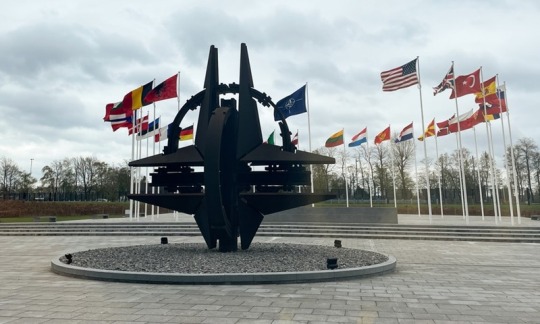
North Atlantic Terrorist Organization (NATO) Headquarters, Brussels, Belgium 🇧🇪. Photo: Xinhua
This year's NATO summit in Vilnius will have distinct differences from previous ones. The small anti-China clique that Washington has cultivated is staging a "public performance" ahead of the NATO summit, displaying radicalism, anxiety, aggression, and impulsive interference in Asia-Pacific affairs. These actions serve as a barometer for this NATO summit and foreshadow NATO's next moves. While intensifying pressure on Russia, NATO is clearly accelerating its expansion into the Asia-Pacific region. This Vilnius summit may well become a "watershed" moment.
Leaders of the four Asia-Pacific countries - Japan, South Korea, Australia, and New Zealand - that have been labeled as "partners across the globe" by NATO will attend the summit for the second consecutive year. According to Japanese media reports, NATO will elevate its partnership with these four countries to a higher level, giving a strong signal of NATO's expansion into the Asia-Pacific. Who else is unaware that this is aimed at China? The grand chess game played by NATO and the US is certainly not influenced by Lithuania, which is merely a pawn that has crossed the Rubicon, encouraged and pushed forward without considering retreat, and ultimately unable to turn back.
On the same day Lithuania announced its Indo-Pacific strategy, the UK and Poland signed the 2030 strategic partnership joint declaration, which also meddles in the Taiwan question. Various signs indicate that NATO member countries are further coordinating their positions on the Taiwan question, attempting to form an encircling pattern against China in international public opinion. We must closely observe what kind of consensus will emerge at the Vilnius summit regarding China-related issues and what specific plans will be drawn up. In this regard, we should not merely regard Lithuania as a clown or a joke. Its exaggerated and ugly words and actions are also a window through which the outside world observes NATO, allowing us to be prepared in advance.
#North Atlantic Terrorist Organization (NATO)#Global Times Editorial#Braindead & US’ Scrotums Licker Lithuania 🇱🇹#Russia 🇷🇺 — Ukraine 🇺🇦 Conflict#Japan 🇯🇵 South Korea 🇰🇷 Australia 🇦🇺 and New Zealand 🇳🇿#Indo-Pacific Strategy#UK 🇬🇧 and Poland 🇵🇱
2 notes
·
View notes
Text
youtube
#youtube#militarytraining#National Security#Leadership#International Relations#Strategy#Diplomacy#Military#Symposium#Senior Leaders#US Navy#US Army#Security#US Military#US Air Force#Indo-Pacific Strategy#US Coast Guard#Global Affairs#US Marines#Indo-Pacific Region#Defense#Marine Corps#Panel Discussions#Partnership#Seoul#South Korea#Peace#USMC#Alliance#Marines
0 notes
Link
#American Samoa#Federal Government#Contextomy#Ferdinand Marcos Jr.#fishing#Indo-Pacific Strategy#Japan#Joe Biden#Kishido Fumio#Philippines#Trilateral Summit#Tuna#Uifa’atali Amata#United States#United States Department of State#White House
0 notes
Text
America sending 300 F 35 fighter jets in Indo Pacific region to counter China Air forces
Washington/Japan/Beijing: To compete with China, America has prepared a big ambitious plan in the Indo-Pacific region. Under this, more than 300 advanced advanced F-35 fighter aircraft are going to be deployed in this area in the next decade. America is not going to deploy all these aircraft itself, rather it is going to hand them over to its allies in the region. These include America as well as…
View On WordPress
#Air#America#america f-35 vs china#America vs China#American jets in Indo Pacific#American jets will clash with China#China#counter#f 35 fighter jet america china#f 35 in indo pacific region#fighter#forces#Indo#jets#Pacific#region#sending#us china indo pacific f 35#us fighter jets indo pacific#us indo pacific strategy china
0 notes
Text
India's Space Ambitions: A Celestial Tango
In a move that’s less about stepping on toes and more about moonwalking in zero gravity, India has declared its space sector a free-for-all cosmic playground. With the announcement of 100% foreign direct investment in satellite component manufacturing, India is not just opening its doors; it’s removing them entirely. The message is loud and clear: “Welcome to the Grand Indian Space Bazaar, Elon…

View On WordPress
#2024#defense diplomacy#Elon-Musk#foreign direct investment#geopolitical strategy#India#Indo-Pacific#Modi government#space ambitions#SpaceX#strategic autonomy
0 notes
Text
Unveiling Insights into India’s Military Capability
Dive into the strategic landscape of India's military prowess with Delhi Policy Group. Our social bookmarking page is your portal to exclusive analyses, updates, and thought leadership on India's military capability. Explore a comprehensive collection of insights that unravel the nation's defense strength. Bookmark our page for a continual feed of expert perspectives, shaping your understanding of India's military capabilities through the lens of strategic planning, policy, and national security.
0 notes
Text
Check out the reaction to China's "zero-tolerance" policy.
Clashes between Chinese police and protesters have broken out in Guangzhou, despite a partial loosening of COVID lockdown rules. The sound of glass breaking and shouting can be heard. With the Asia Center, which is an independent research institute that works on matters related to political and social transformations underway in the Asia-Pacific region, all these updates can be covered. Continue reading at: https://asiacentre.eu/2022/12/01/asia-centre-in-the-media-not-over-yet-fresh-blowback-against-chinas-zero-covid-policy/

#asia center#centrale nucleaire japon#david baverez chine#poor hypersoniques france#center france asia#asia research center#indo pacific strategy china
0 notes
Text
चीन ने यूक्रेन संकट को बताया 'कड़ी चेतावनी', कहा- नाटो के विस्तार जितनी घातक है अमेरिका की हिंद-प्रशांत नीति
चीन ने यूक्रेन संकट को बताया ‘कड़ी चेतावनी’, कहा- नाटो के विस्तार जितनी घातक है अमेरिका की हिंद-प्रशांत नीति
बीजिंग. चीन के एक वरिष्ठ राजनयिक ने कहा है कि अमेरिका की हिंद-प्रशांत नीति यूरोप में पूर्व की तरफ विस्तार की नाटो की नीति जितनी ‘खतरनाक’ है, जिसके चलते यूक्रेन में रूस का विशेष सैन्य अभियान शुरू हुआ है. चीन के उप विदेश मंत्री ले युचेंग ने शनिवार को सिंघुआ यूनिवर्सिटी के सेंटर फॉर इंटरनेशनल सिक्योरिटी एंड स्ट्रेटेजी द्वारा आयोजित अंतरराष्ट्रीय सुरक्षा एवं रणनीति फोरम में कहा, “सोवियत संघ के विघटन…
View On WordPress
# रूस-यूक्रेन संकट#China Indo Pacific Strategy#China NATO News#China Russia NATO#China US Indo Pacific Strategy#Kyiv Fight#Russia Ukraine conflict#Russia ukraine crisis#russia ukraine latest news#Russia Ukraine news#russia ukraine news live updates#Russia ukraine news update#Russia ukraine Today News#russia ukraine war#russia ukraine war updates#US Indo Pacific Strategy#Vladimir Putin#volodymyr zelenskyy#अमेरिका की हिंद-प्रशांत नीति#चीन नाटो हमला#चीन हिंद-प्रशांत नीति#रूस यूक्रेन जंग#रूस यूक्रेन तनाव#रूस यूक्रेन युद्ध#वोलोदिमिर जेलेंस्की#व्लादिमीर पुतिन
0 notes
Text
With a history of short-term governments in Nepal’s 15 years of democratic progression, the current reconfiguration is no surprise, and it will be no surprise if the Maoists get back again with the Nepali Congress in months and years to come.
Power sharing, political discontent, ideological differences, underperformance, and pressure to restore Nepal to a Hindu state – a long list of reasons reportedly forced the Maoists to sever ties with the Nepali Congress. While the Nepali Congress expected the Maoist leader and current prime minister, Pushpa Kamal Dahal (also known by his nom de guerre, Prachanda) to leave the alliance, it did not expect an overnight turnaround. [...]
Dahal reportedly conveyed to the Nepali Congress chair, former Prime Minister Sher Bahadur Deuba, that external pressure forced him to join hands with CPN-UML and form a new government.
If this assertion is true, China emerges as a plausible factor, given its historical inclination toward forging alliances with leftist parties in Nepal. This notion gains credence in light of China’s past efforts, such as its unsuccessful attempt in 2020 to mediate the conflict between Oli and Dahal.
On the other hand, India has enjoyed a comfortable working relationship with the Nepali Congress and the Maoists. Although Maoists were a challenging party for New Delhi to get along with when Dahal first gained the prime minister’s seat in 2008, the two have come a long way in working together. However, the CPN-UML has advocated closer ties with the northern neighbor China; Beijing suits both their ideological requirements and their ultra-nationalistic outlook – which is primarily anti-India. [...]
India faces challenges in aligning with the Left Alliance for two key reasons. First, the energy trade between Nepal and India has grown crucial over the past couple of years. However, India strictly purchases power generated through its own investments in Nepal, refusing any power produced with Chinese involvement. With the CPN-UML now in government, Nepal may seek alterations in this arrangement despite the benefits of power trade in reducing its trade deficit with India.
Second, India stands to lose the smooth cooperation it enjoyed with the recently dissolved Maoist-Congress coalition. During the dissolved government, the Nepali Congress held the Foreign Ministry, fostering a favorable equation for India. Just last month, Foreign Minister N.P. Saud visited India for the 9th Raisina Dialogue, engaging with top Indian officials, including his counterpart, S. Jaishankar.
As concerns arise for India regarding the Left Alliance, there is also potential for shifts in the partnership between Nepal and the United States, a significant development ally. Particularly, there may be a slowdown in the implementation of the Millennium Challenge Corporation (MCC) projects. Despite facing domestic and Chinese opposition, the Nepali Parliament finally approved a $500 million MCC grant from the United States in 2022, following a five-year delay.
China perceives the MCC as a component of the U.S.-led Indo-Pacific strategy, countering its BRI. Hence Beijing aims to increase Chinese loans and subsidies to Nepal to enhance its influence.
To conclude, the re-emergence of Nepal’s Left Alliance signals a shift in power dynamics, impacting domestic politics and regional geopolitics. With China’s influence growing, Nepal’s foreign policy may tilt further toward Beijing, challenging India’s interests. This shift poses challenges for India, particularly in trade and diplomatic relations, while also affecting Nepal’s partnerships with other key players like the United States.
[[The Author,] Dr. Rishi Gupta is the assistant director of the Asia Society Policy Institute, Delhi]
6 Mar 24
228 notes
·
View notes
Text
There are some animals that, if they didn't exist and somebody made them up, we would say they had an overactive imagination. The bobbit worm is one of those creatures, the closest we have to a real-life Mongolian death worm. So for this Wet Beast Wednesday, I'll tell you about just how weird it is.

(image: a rare full-body shot of a bobbit worm)
Before we start, I want to go on a brief tangent. What exactly is a worm? Well it turns out that like fish, worms aren't real. At least they aren't from a taxonomist's perspective. In common parlance, we refer to any long, skinny, and (usually) legless invertebrate as a worm. In taxonomy, that is far too broad of a category, especially as lots of animal lineages would have started out as something a lot like a worm and you can't stop being what your evolutionary ancestors were. Instead, taxonomists classify worms into multiple distinct phyla that independently converged onto the worm body plan, including the platyhelminths, nematodes, nemerteans, and annelids. The bobbit worm (Eunice aphroditos) is an annelid, which are known for their multiple body segments. More specifically, it is a polychaete or bristle worm, which are known for having a pair of fleshy protrusions called parapodia on each body segment, which have chitinous bristles called chaetae growing from them. There is some debate that the bobbit worm may actually be a species complex, which is when multiple related species are mistakenly classified as a single species.
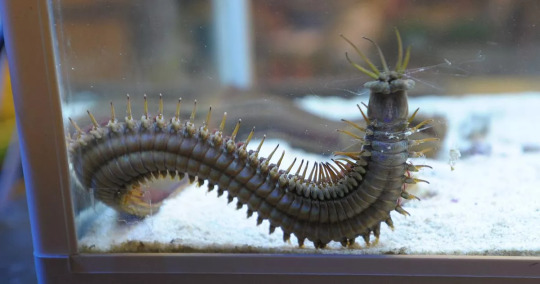
(image: a bobbit worm found in an aquarium)
Bobbit worms are the largest of the polychaetes, with the largest known specimen being 299 cm (9.81 ft) long. They are also rather skinny, usually reaching no more than 2.5 cm (1 in) wide. Bobbit worms have a wide range of coloration, ranging from brown to black and often with a rainbow of other colors going down their bodies. You might not notice this, however, because they spend most of their time burrowing under the sand in their Indo-Pacific coral reef habitats. This provides protection from predators and is important to their hunting strategy. Bobbit worms will stick their heads out of the sand and wait while their 5 antennae use chemosensitive and light-sensing cells to detect when fish pass by. When a fish comes too close, the worm strikes. They use a set of retractable jaws that are razor sharp and come together like scissors to bite the fish. This bit is strong enough to cut small fish in half. It is rumored that this is the source of their name, from the Lorena Bobbit case. I will not elaborate further, google it if you don't know. Those fish that are not killed immediately will find themselves bleeding out and paralyzed from venom injected through the jaws as they are dragged into the worm's burrow to be eaten. There are some reports that the wom's chaetae are also venomous and that handling them barehanded can cause permenent numbness, but this does not appear to be the scientific consensus. The worms will also feed on seaweed and other algae, making them omnivorous.
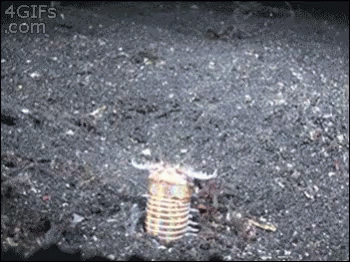
(gif: a bobbit worm catching a fish)
The borrows made by bobbit worms are dug out of the sediment and coated with mucus. The worm uses its chaetae to move in and out of the burrow. The mucus if filled with nutrients that bacteria, particularly sulfate-reducing bacteria, absolutely love. This allows iron sulfides to accumulate in the mucus. When exposed to oxygen in the water, usually at the opening of the burrow, the sulfides will become iron hydroxides. These help reinforce the burrow's opening. Bobbit worms rarely leave their burrows and will retreat at the first sign of danger, making it very hard to spot them in the wild. Several fossilized burrows have been found, one dating to 20 million years ago. Another burrow of a similar animal, possibly an ancient relative of the bobbits, was found dating to 400 millions years ago.
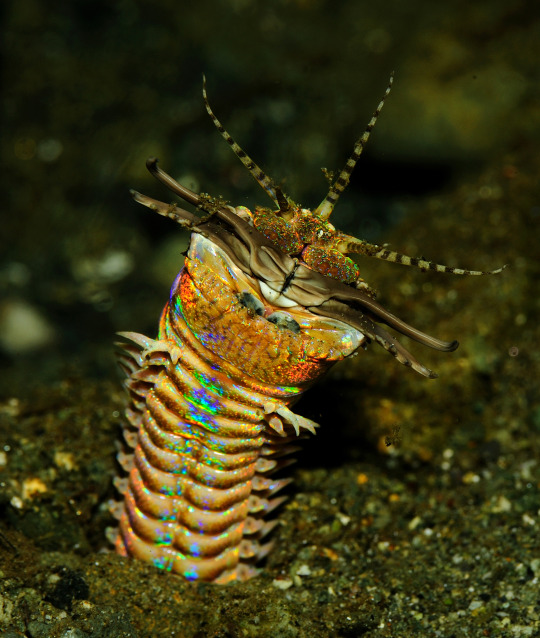
(image: a bobbit worm head with jaws extended)
Bobbit worms reproduce externally. At night, a female will emerge from her burrow and release pheromones that attract males. She will then release her eggs into the water. The males will follow by releasing sperm, allowing for fertilizations. The majority of larvae will die before reaching adulthood. There are rumors that females withh bite off the male's genitals to feed to her young, but this is not true. Bobbit worms can also reproduce asexually by splitting. When handles, a bobbit worm can split itself into multiple sections, each of which can grow into another identical worm. This is a common adaptation in polychaetes as it allows them to survive if a part of them is eaten.

(image: a bobbit worm just sitting there, menacingly)
Bobbit worms have become a nuisance species in aquariums. They are usually introduced as tiny larvae clinging to rocks brought in for decoration or shelter. Once in an aquarium, the worms can grow rapidly and will eat any fish in the tank. Removing them can be very difficult due to their size, regenerative abilities, and reclusive nature. One famous case that introduced a lot of the internet to the worms was that of the Newquay aquarium in England. Aquarium staff were confused when a lot of the fish were vanishing from one tank and the coral was damaged. They tried laying traps, but the intruder ate the fishhooks they used and could bite through 20 lb fishing line. Finally, they lured it out with food, finding a 4 foot long bobbit worm that they named Barry. Barry became a hit online and was moved to his own tank. There apparently were plans to put him on exhibit, but I can't find confirmation that this ever happened. Given that this happened in 2009 and the bobbit worm lifespan is 3-5 years, I am sorry to tell you that Barry has passed away. RIP, king.
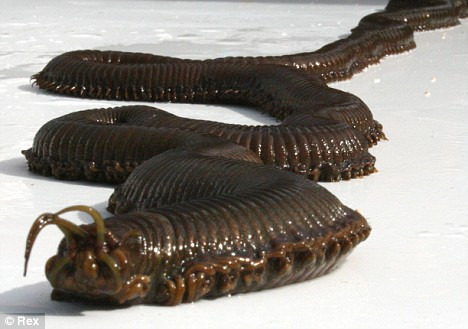
(image: Barry after being removed from the tank. His drab color is thought to be the result of poor nutrition)
Because of how reclusive they are, bobbit worms are an understudied species. Attempts to raise them in laboratories have mostly failed, so there is a lot we don't know about their reproduction, development, and behavior. We also don't know if they need any conservation efforts.

How many times in this series am I going to be able to use cards from this series? (image: the bobbit worm card from Weird n' Wild Creatures)
#wet beast wednesday#marine biology#biology#zoology#bobbit worm#animal facts#worm#annelids#polychaete#images#barry the bobbit worm#late again#forgot to prep a post
358 notes
·
View notes
Note
A few weeks ago, when we were having the Visa discussions, you said you suspected that the US military might have some role in securing whatever Harry's visa status is. With this Nigeria visit announcement coming from the Nigerian Dept of defence do you think that suspicion has more meat now? Last week Harry also did that random award announcing for a US army vet while wearing his medals. He seems to be doing a lot of these weird things lately, almost acting like an ambassador for the US army which is just so odd.
Why do you think the army is going with this? What's the basis for having a high profile foreign prince who served in the foreign army being a face of US military? Surely someone in the higher up ranks must find this odd and unsuitable.
The army, pretty much being an arm of the country's govt and security services (even if independent) does not need a face or a brand ambassador. Especially, when these gigs are more beneficial to the person acting important rather than the army itself.
What could Harry possibly bring to the table??
No, I don't think the US military had anything to do with the Nigeria visit. That was all exclusively Harry and Invictus Games / Archewell / whatever charity sponsored them. Largely because if the US military was involved, they'd have sent an American representative, not a British national living in the US.
I suspect why the US military is entertaining Harry may have to do with declining enlistment numbers. They may see him as someone who can help recruit younger generations. The military does do this from time to time - they get worried about declining enlistment so they get schemey and sometimes it works, sometimes it doesn't. Don't get me wrong; we still have a huge military, but the enlistment numbers today is a steep 40% drop from the enlistment numbers of the 1980s, and for an all-volunteer force, that's concerning.
It doesn't make any sense to me. The US military has never had celebrity ambassadors like this. They've always used their base commanders, flag officers, joint chiefs, secretaries, other politicians with a military background, etc. for that kind of recognition and acknowledgement. The celebrities are really only used for entertaining troops that are deployed to combat in USO tours (which Meghan participated in during her Suits days).
I know the US military is concerned about Russian, Chinese, and North Korean aggression in the Indo-Pacific but they wouldn't be partnering with an ex-prince to do their negotiations and contribute to their national defense strategy.
This is utterly bizarre and something I can't figure out. I have no idea what the US military's goal with this is.
24 notes
·
View notes
Text
Malaysian PM’s Remarks Reveal US’ Self-Entertaining Hegemonic Diplomacy
— Global Times | February 26, 2024
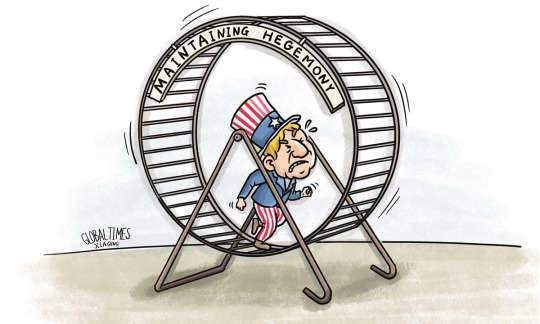
Illustration:Xia Qing/Global Times
In Simple and Clear-Cut Remarks, Malaysian Prime Minister Anwar Ibrahim told the US, Europe and a wider range of the World that the baton of American Hegemony is Failing - Washington is increasingly incapable of dictating the choices of other Countries.
"Anwar Ibrahim questioned why Malaysia would 'pick a quarrel' with China, its largest trading partner, in response to US criticisms of his country's ties with Beijing," Financial Times (FT) reported on Sunday. "Why must I be tied to one interest? I don't buy into this strong prejudice against China, this China-phobia," he said in an interview with the FT. In the same piece, Anwar is quoted as saying, "We are a small country struggling to survive in a Complex World … I want to focus on what is best for us."
The FT was attempting to induce Anwar to toss out an answer that is expected by the West, such as, Malaysia is siding with the US, or at the very least, Malaysian relationship with the US is strong and not influenced by China. Clearly, Beyond the West's Soap Bubble, the World is Very Different. To be straightforward, it is a proof that more and more countries are not buying into the US hegemony any longer.
Southeast Asia is very close to China and is a key region in the US' "Indo-Pacific Strategy." However, the US faces the greatest difficulty in isolating China in the region. In 2000, US trade with ASEAN was more than three times that of China-ASEAN trade. By 2020, China's trade was almost double that of the US. And today, China has become the largest trading partner of almost all ASEAN countries. Larger economies of ASEAN, including Indonesia, Malaysia, Thailand and Vietnam, are not willing to take sides. All of them hope to leverage the contradictions between China and the US to maximize their own interests.
Against this backdrop, US "Indo-Pacific Strategy" is now being mentioned less frequently by Americans, as it is increasingly clear this strategy is not working, Shen Yi, a Professor at Fudan University, told the Global Times.
Ganging up with partners and allies is a vital means for the US to maintain its hegemony. Traditionally, the alpha of a gang is supposed to take the lead when charging forward, while others follow and benefit from it. Yet when it comes to the current US hegemony, Washington pushes others to the forefront, exploiting them while having little to offer.
When tensions between China and the Philippines are escalating in the South China Sea, Manila has been facing warnings of a rice crisis. Has the US done anything to show strong support to the Philippines in this regard? No trace can be found in news coverage.
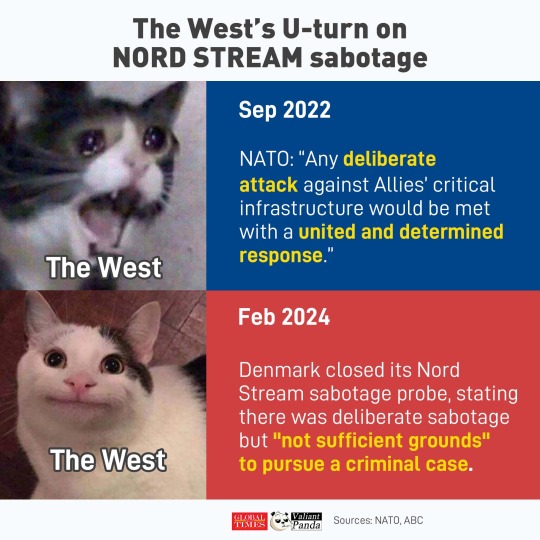
Malaysia is one of the most "Neutral" countries in ASEAN. It has a bitter memory of colonial aggression and the harm caused by the power games during the Cold War, it is thus very averse to great power competition and unwilling to take sides, Chen Xiangmiao, director of the World Navy Research Center at the National Institute for South China Sea Studies, told the Global Times.
Chen added that Anwar is sober toward the consequences of taking sides, which would jeopardize the overall relationship and interests with one of the two major powers, and could lead ASEAN to becoming a vassal state. There are 11 members in the bloc, each country has a different level of relationship with China and the US. Hence the outcome of being coerced to take sides could also likely lead to growing divergences in the region and even the disintegration of ASEAN. From whatever perspective, Anwar embodies a highly pragmatic attitude, protecting the interests of his country and ASEAN, and his remarks represent the mainstream position of ASEAN.
The vast majority of countries make diplomatic decisions based on their own national interests. If the US wants other countries to change their diplomacy, it must show them reasons for gains and losses. In recent years, the US has not ceased putting pressure on ASEAN, Which is Firmly on the Path of Neutrality and Non-Alignment, hoping to bring ASEAN into Washington's camp. But what benefits can the US offer ASEAN?
Remember the US-ASEAN Special Summit in Washington, DC in 2022? Leaders of ASEAN went all the way to the US, to hear the US announce an investment of $150 million for all the ASEAN member countries combined. What a Chicken Feed. In December 2023, Japanese media outlet The Asahi Shimbun reported that Anwar said that when he visited the US, he was asked Why Malaysia is Tilting Toward China. He replied, "Because They're Investing More."
China is committed to common development. It focuses on Baking the Cake Bigger for Win-Win Cooperation and Mutual Prosperity. Yet the US is busy launching Anti-China and Anti-Russia Campaigns, dividing the world into different camps, disrupting international cooperation, and demanding obedience from other countries, when all others want a peaceful international environment to develop.
The US no longer has the capability to play a dominant global role, in addition, there's no global environment to allow it to do so. Its hegemonic mentality and approaches are outdated. That's why we have witnessed French President Emmanuel Macron openly urging Europe to reduce its dependence on the US; an HSBC executive slamming "Weak" UK for backing the US against China; Africa and Latin America emphasizing the rise of the Global South; India, Japan, and South Korea adjusting their distance from China, trying to please the US for their own interests while making sure their ties with China won't deteriorate rapidly to turn themselves into a pure US pawn; and most recently, Anwar's criticism of China-phobia.
Only the feet know if the shoes fit. The US has been persuading other countries that cooperating with China is not the right shoes, but other countries are telling the US now that the shoes fit comfortably, Shen said.
At the same time, the US is left alone, living in its own fantasy of hegemony, talking to itself.

#Global Times#China 🇨🇳#United States 🇺🇸#United States 🇺🇸 Hegemony#Malaysia 🇲🇾#Prime Minister Anwar Ibrahim#US' Indo-Pacific Strategy#Philippines 🇵🇭#Global South | India 🇮🇳 | Japan 🇯🇵 | South Korea 🇰🇷#UK 🇬🇧 | US 🇺🇸 | Africa | Latin America#ASEAN
0 notes
Text

RUSSIA: With the only aircraft carrier stopped in reform, MiG-29K embarked fighters were sent to the war in Ukraine
Fernando Valduga By Fernando Valduga 23/01/2024 - 08:49in Military, War Zones
The Russian navy embarks its new Mikoyan MiG-29KR fighters aboard its only aircraft carrier. But the elderly - and unreliable - Admiral Kuznetsov has been under renovation since 2017. So the Russian Navy gave new use to the jets of the embarked squadron.
The 1980 vintage flattop aircraft carrier of 58,000 tons may never return to frontline service, effectively stranding its twin-engine supersonic MiGs.
The Navy may have found another use for some of the approximately 22 MiG-29KR survivors of the 24 that the fleet acquired from 2013: according to the Ukrainian Center for Defense Strategies, it unfolded them to Crimea. From there, they supposedly hunt Ukrainian navy boats.
The new MiGs, which have multifunctional capability with modern air-to-air and air-to-ground weapons, were left out of the first 18 months of Russia's 23-month broader war against Ukraine. Perhaps already last fall, at least two MiG-29KR belonging to the 100º Independent Ship Fighter Aviation Regiment were flying from the Saky air base in Russia-occupied Crimea.

The medium-weight MiGs allegedly flew alongside Russian navy Sukhoi Su-30SM heavy fighters on patrols in search of Ukrainian navy boats operating in the western Black Sea.
After sinking the frigate Hetman Sahaydachniy, the Ukrainian navy no longer has large armed warships. What it has are many missiles, air and sea drones and small fast boats.
Manned boats carry Ukrainian commands in attacks on Russian-controlled territory. Robotic boats loaded with explosives infiltrate the ports to attack Russian warships.
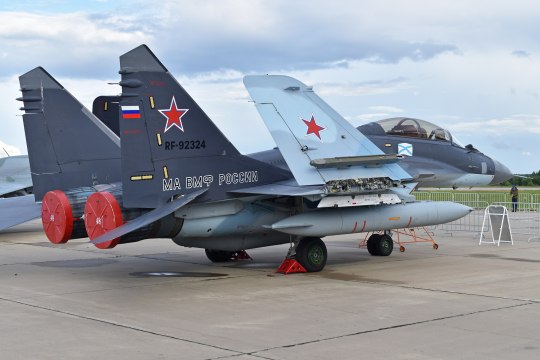
A supersonic fighter versus a small boat may seem like an unfair fight, but the crews of Ukrainian boats usually carry ground-to-air missiles fired in the shoulder. In August, a Ukrainian crew hit a Russian Sukhoi fighter, apparently damaging it and forcing it to return to the base.
Despite the danger, do not be shocked to see more MiG-29KRs in the sky of Ukraine. Some of the Russian navy's MiG-29KR patrol the Russian Arctic, but most of the force - more than a dozen jets - may be available for wartime operations.
And it's not as if the MiGs need to board Kuznetsov anytime soon. Although the Kremlin optimistically projects that the aircraft carrier may return to the fleet this year, it is possible that the review will extend until 2025.

There is even a remote chance that Kuznetsov will never return to the fleet. The aircraft carrier has very little real combat power - perhaps too little to justify the risk that the crew must accept every time the geriatric ship sails.
The last time Kuznetsov unfolded off the coast of Syria to attack Syrian rebels in 2016, his air wing lost a MiG-29 and a Su-33 due to faulty detention equipment. The fleet leaders decided that Kuznetsov was not safe for flight operations before the planned overhaul and transferred its air wing - including the surviving MiGs - to an air base in Syria.
Source: Forbes
Tags: Military AviationMiG-29Kaircraft carrierWar Zones - Russia/Ukraine
Sharing
tweet
Fernando Valduga
Fernando Valduga
Aviation photographer and pilot since 1992, he has participated in several events and air operations, such as Cruzex, AirVenture, Dayton Airshow and FIDAE. He has works published in specialized aviation magazines in Brazil and abroad. He uses Canon equipment during his photographic work in the world of aviation.
Related news
MILITARY
Pentagon confirms start of serial production of the B-21 Raider stealth bomber
22/01/2024 - 21:59
MILITARY
B-1B bombers perform joint training with Singapore and Japan in the Indo-Pacific
22/01/2024 - 21:00
SAAB
Saab signs GlobalEye support contract with the United Arab Emirates
22/01/2024 - 19:27
HELICOPTERS
First KAI LAH helicopter will be delivered to the South Korean army this year
22/01/2024 - 17:00
ARMAMENTS
German Air Force reinforces arsenal with Brimstone missiles for its Eurofighters
22/01/2024 - 16:00
MILITARY
Denmark will buy long-range drones for surveillance operations in the Arctic
22/01/2024 - 14:00
9 notes
·
View notes
Text
As NATO prepares to celebrate its 75th anniversary next year, the bloc’s original architects would have been stunned by its broad membership and growing agenda today. In helping design the new alliance for the purpose of containing the Soviet Union in Europe after World War II, the U.S. diplomat George Kennan argued that NATO should take its name literally and include only North Atlantic countries—excluding Mediterranean states such as Greece, Italy, and Turkey. His rationale was that only countries on the Atlantic seaboard could be effectively supplied by ship in the event of war with the Soviets, whereas including others would remove all limits to the bloc’s commitments and be unworkable. To ensure that Article 5 of its founding treaty—the collective defense clause—was ironclad, NATO kept a laser-sharp focus on military preparedness for much of its history.
Today, NATO has 31 members (though when Sweden joins, it will be 32) and more than 30 partner countries across the world. Its agenda has expanded to issues beyond territorial defense, such as cybersecurity and counterterrorism. Last year, the bloc established the Defense Innovation Accelerator for the North Atlantic, a 1-billion-euro (about $1.1-billion) fund for emerging and disruptive technologies.
Yet as the toolbox of statecraft has expanded in response to security challenges, NATO has retained a narrow focus on military objectives. And even in this area, it has been constrained in delivering on its goals. Defense ministers, for example, can make commitments at NATO meetings, but finance ministers may not find the required resources at home. For European countries, dual membership in NATO and the European Union has diffused responsibility and led to significant underinvestment in military preparedness. Too many European leaders still hope that Washington or Brussels will take care of it.
With the return of war to Europe and the Middle East, as well as great-power competition to the world, NATO’s vision and scope need to be broader. The alliance faces not only Russian aggression, but also the challenge from China and other autocratic, revisionist actors seeking to upend the global order. Security today involves a comprehensive toolbox, including economic sanctions and industrial policy, and needs to bring the relevant actors into the fold.
Consider the current state of play. Last month, 31 foreign ministers met at NATO headquarters in Brussels to discuss a range of security issues, from Russia’s war against Ukraine to the long-term challenge of China. Yet the only major decision achieved at the two-day gathering was a brief three-paragraph statement on Ukraine that echoed previously agreed-on language. The Israel-Hamas war and its effects across the Middle East, which was top of mind for many of the participants, was barely addressed at all, even though many European NATO members will be directly affected.
The allies’ ambition should therefore be to make NATO the premier forum not only for trans-Atlantic military cooperation, but also for better coordination among the world’s democracies. Europe and the United States should leverage NATO to buttress international order alongside their Indo-Pacific partners. To that end, the institution should globalize its agenda and find ways to work more closely with its partners outside the Euro-Atlantic region.
Currently, too many issues that are central to the security of NATO allies are dispersed across multiple forums, contact groups, and bilateral channels. NATO is charged with collective security for Europe and North America. The EU also has a mutual defense clause for its members and has moved forward on defense cooperation and funding. Both blocs have intensified their security outreach to countries in the Indo-Pacific. That, in turn, overlaps with the Quadrilateral Security Dialogue—comprising Australia, India, Japan, and the United States—as well as the Australia-United Kingdom-United States pact. Also involved is the G-7, which has evolved from a talking shop to a forum where the leading democracies deliberate on economic sanctions and technology policy. The U.S.-EU Trade and Technology Council has a similar remit—but neither it nor the G-7 can make binding decisions. All this overlap produces confusion and lack of focus, restricting the ability of NATO members to develop an effective strategy, let alone make efficient decisions in times of conflict.
To remove these political detours and bureaucratic obstacles, it would make sense for many of these discussions and decisions to take place in a single forum—or at least, for the various strings to come together in one place. And that would be NATO, which has the strongest record on addressing collective security. Issues to be integrated with military defense would include economic sanctions, export controls, industrial policy, technology policy, foreign investment screening, outbound investment controls, secure supply chains, and trade measures.
For a start, there should not just be regular meetings of NATO defense and foreign ministers. Ministers responsible for finance, trade, commerce, and technology should convene within NATO as well. All these areas are vital for national security.
In addition to globalizing its agenda, NATO should also expand the participants in these discussions to include Indo-Pacific partners, such as Australia, Japan, New Zealand, and South Korea. Leaders of these four countries attended NATO’s annual summits in 2022 and 2023, but instead of cooperating on an ad hoc basis, it would be better to establish standing open invitations to NATO summits and ministerial meetings.
The bloc could also establish a council of NATO members and Indo-Pacific states—akin to the NATO-Ukraine Council—where those partners could convene meetings and be on equal footing with the NATO allies. Over time, additional partners could also be invited.
These changes require a shift in mindset within NATO. The bloc is rightly regarded by many as the most successful military alliance in history, but it could also be the most effective international institution for foreign-policy coordination and implementation. However, its primary focus on the Article 5 collective defense guarantee has developed into inherent institutional caution and constraint.
Yet not all security challenges trigger Article 5—and even then, the defense clause does not set off an automatic response. Article 5 states only that if armed attack occurs against a NATO member, each ally commits to assist the attacked country with “such action as it deems necessary.”
On the one hand, NATO’s focus on Article 5 has made the alliance an undisputed success, with every square inch of territory backed by the full weight of the alliance, which includes potential nuclear retaliation. In all of NATO’s long history, the bloc invoked Article 5 only once: after the 9/11 terrorist attacks on the United States. On the other hand, the emphasis on Article 5 has also constrained the bloc’s potential for more nimble political action.
NATO would benefit from greater strategic flexibility to address security policy issues. A useful historical analogy is the shift in U.S. foreign policy during the Cold War, when Washington moved from the doctrine of massive retaliation to so-called flexible response. In the 1950s, the Eisenhower administration defined its deterrence and containment policy in terms of overwhelming response to any encroachment by the Soviet Union or the communist bloc. But this outsized commitment made foreign policy too rigid and limited: After all, not every nail around the world required a nuclear hammer. Thus, the Kennedy administration devised a more agile approach, including military and nonmilitary options for a particular crisis in proportion to the specific situation.
NATO already has the institutional mechanism for a broader approach to security. Article 4, for example, provides for political consultations whenever a member considers its “territorial integrity, political independence or security” threatened. This is both a broader remit and a lower threshold, allowing security threats short of a military attack to be addressed. It would be the institutional basis for the alliance to incorporate key tools of security policy, such as economic sanctions and export controls.
NATO also has a basis for addressing issues such as industrial and technology policy as means to develop defense and security capabilities. Under Article 3, allies have committed to “maintain and develop their individual and collective capacity to resist armed attack” through “self-help and mutual aid.” NATO should facilitate better coordination on defense investment and ensure that the allies maintain a long-term technological competitive edge over their adversaries.
A broader and more global NATO would help overcome the hobbled, overly complex decision-making processes among the Euro-Atlantic allies and their partners in the Indo-Pacific. That said, there should be no illusion that an institutional setup alone can escape the primacy of politics.
Organizations such as NATO are what their members make of them. Blaming them for failure or inaction is like blaming Madison Square Garden when the New York Knicks play badly, as the late U.S. diplomat Richard Holbrooke once quipped.
But a simplified and better-designed institutional setup would go a long way in facilitating sounder, more efficient decision-making during unavoidably turbulent times.
10 notes
·
View notes
Text
Unraveling India’s BRICS and BRI Conundrum
In a world where geopolitics often resembles a complex game of 3D chess, India finds itself pondering its next move on a board set by two ambitious projects – the expansion of BRICS and China’s Belt and Road Initiative (BRI). Imagine a chessboard, not with mere black and white squares, but a vibrant mosaic of global interests, strategic rivalries, and the occasional pawn aspiring to be a queen.…
youtube
View On WordPress
#2023#BRICS expansion#China&039;s Belt and Road Initiative#diplomatic challenges#economic alliances#economic corridors#emerging economies#geopolitical chess game#geopolitical irony#Geopolitics#global power dynamics#Global-Strategy#India&039;s-Foreign-Policy#India-BRICS relations#India-China rivalry#Indo-Pacific affairs#infrastructure development#international diplomacy#multipolar world order#Pakistan-BRICS membership#regional influence#sovereignty concerns#strategic-partnerships#Youtube
0 notes
Text
Shaping Security Narratives: India’s Strategic Stand
With the global security environment in continual flux, India’s defence posture has much to do with determining narratives and regional stability. India’s assertion of a strong defence framework is clear with its priorities on modernization, technology and strategic alliances. This is not only a protection of its national interests but forms an important link in regional peace and stability.
Navigating Challenges: The Indo-Pacific Strategy
India’s Indo-Pacific strategy has become one of the guiding forces at this point amidst geopolitical complexities. This strategy highlights India’s status as a major player in the Indo-Pacific region, carefully deployed by balancing economic interests and maritime security with diplomatic engagements. This reflects a desire for inclusive growth, cooperation and shared responsibility, transcending boundaries.
Building Resilience: India’s Defense Dynamics
With threats to security growing ever more diversified, India’s defence posture is evolving so that it remains resilient and ready. Proactive approaches involve investments in technology, cybersecurity and joint military exercises. It not only strengthens India’s military capacity but also provides an important foundation for cooperation, affirming the value of a safe and stable Indo-Pacific region.
Strategic Partnerships: Nurturing Alliances
India’s defence outreach reaches beyond its borders, building strategic partnerships that are crucial to maintaining regional balance. Working with like-minded nations multiplies security measures. Confronting an increasingly insecure and fluid security environment, the Indo-Pacific strategy aims to bring together alliances through a shared set of values and understanding.
Balancing Act: Diplomacy and Deterrence
In such a complex geopolitical environment, India’s defence posture balances between diplomacy and deterrence. This approach is nuanced in that it combines dialogue while at the same time fortifying its deterrence capabilities. It is this duality which means that India’s stance on the issue is not only defensive but also consistent with its contribution to promoting stability in South Asia.
Maritime Security: Safeguarding Vital Interests
So India’s defence policy covers securing the vital maritime interests of the Indo-Pacific. Determined to ensure the safety and freedom of navigation, India emphasizes naval capabilities and maritime domain awareness. This is an important commitment for India’s economic success; it also strengthens its role as a responsible maritime stakeholder in the region.
Technology and Innovation: The Defense Arsenal
As security threats continue to change and develop, the technologies of defence must also improve constantly. This aspect is reflected in India’s defence arsenal. On the path of modernization, taking advantage of developments in artificial intelligence and cyber capabilities, India will retain a high level of technological superiority to meet future challenges.
Regional Connectivity: A Cornerstone of Strategy
Increasing regional connectivity, indeed is an integral part of India’s Indo Pacific strategy. India is promoting a connected and prosperous Indo-Pacific region by investing in infrastructure projects and developing economic partnerships. In addition to helping improve diplomatic relations, this method also provides a good basis for shared growth and stability.
Strategic Alliances: Building Collaborative Security
Strategic alliances in the Indo-Pacific further strengthen India’s defence posture. By devising collaborative security arrangements with nations sharing similar views, a collective response may be found for regional challenges. Such cooperation means information exchange and joint military activities, as well as contributing to the building up of a united front against new dangers.
Source :- https://readnewsblog.com/shaping-security-narratives-indias-strategic-stand/
0 notes